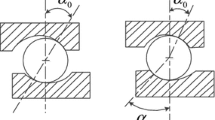Abstract
The heavy load mechanical spindle is an important functional component in a 5-axis computer numerical control (CNC) machine tool, which is used to process large and complex free-form surfaces. It is necessary to obtain the natural frequency and analyze the spindle stability for improving the machining precision. In this paper, Timoshenko beam theory is introduced to model the mechanical spindle shaft, where the centrifugal force and gyroscopic effects are considered. Stability of the heavy load mechanical spindle shaft is analyzed, and the buckling load of the spindle shaft is obtained under different rotational speeds. The natural frequency of spindle is investigated in a freedom and restraint state, respectively. Comparing the proposed method with the simplified hollow cylinder and shaft prototype in the freedom state, the results show that they are highly correlated with experimental results. For the restraint state, the axial load, rotational speed, gyroscopic effect, and centrifugal force are discussed, and all of these parameters affect the natural frequency. The proposed modeling approach can be used for spindle design and optimization in a given machining process and can be easily extended to other spindle design.
Similar content being viewed by others
References
G. L. Xiong, J. M. Yi, C. Zeng, H. K. Guo et al., Study of the gyroscopic effect of the spindle on the stability characteristics of the milling system, Journal of Materials Processing Technology, 138 (2003) 379–384.
B. W. Huang and H. K. Kung, Variations of instability in a rotating spindle system with various bearings, International Journal of Mechanical Sciences, 45 (2003) 57–72.
B. W. Huang, The crack effect on instability in a machine tool spindle with gas bearings, Journal of Sound and Vibration, 286 (2005) 1001–1018.
V. Gagnol, B. C. Bouzgarrou, P. Ray et al., Stability-based spindle design optimizsation, Journal of Manufacturing Science and Engineering, 129(4) (2007) 407–415.
Y. Cao and Y. Altintas, A general method for the modeling of spindle-bearing systems, Journal of Mechanical Design, 126(11) (2004) 1089–1104.
Y. Cao, Modeling of high-speed machine-tool spindle systems, Dissertation of Ph.D, University of British Columbia, 2006.
Y. Altintas and Y. Cao, Virtual design and optimization of machine tool spindles, CIRP Annals-Manufacturing Technology, 54 (2005) 379–382.
E. Abele, Y. Altintas and C. Brecher, Machine tool spindle units, CIRP Annals — Manufacturing Technology, 59 (2010) 781–802.
H. Li and Y. Shin, Integrated dynamic thermo-mechanical modeling of high speed spindles, Part 1: Model Development, Journal of Manufacturing Science and Engineering, 126(2) (2004) 148–158.
H. Li and Y. Shin, Integrated dynamic thermo-mechanical modeling of high speed spindles, Part 2: Solution procedure and validations, Journal of Manufacturing Science and Engineering, 126(2) (2004) 159–168.
H. Q. Li and Y. C. Shin, Analysis of bearing configuration effects on high speed spindles using an integrated dynamic thermo-mechanical spindle model, Int. J. of Machine Tools & Manufacture, 44 (2004) 347–364.
S. Jiang and S. Zheng, A modeling approach for analysis and improvement of spindle-drawbar-bearing assembly dynamics, International Journal of Machine Tools & Manufacture, 50 (2010) 131–142.
S. Jiang and H. Mao, Investigation of variable optimum preload for a machine tool spindle, International Journal of Machine Tools & Manufacture, 50 (2010) 19–28.
S. H. Gao, X. H. Long and G. Meng, Nonlinear response and nonsmooth bifurcations of an unbalanced machine-tool spindle-bearing system, Nonlinear Dyn, 54 (2008) 365–377.
J. T. Sawickia, E. H. Maslenb and K. R. Bischo, Modeling and performance evaluation of machining spindle with active magnetic bearings, Journal of Mechanical Science and Technology, 21 (2007) 847–850.
S. H. Farghaly, Vibration and stability of Timoshenko beams with discontinuities in cross-section, Journal of Sound and Vibration, 174(5) (1994) 591–605.
J. B. Kosmatka, An improved two-node finite element for stability and natural frequencies of axial-loaded Timoshenko beams, Computer & Structures, 57(1) (1995) 141–149.
E. Esmailzadeh and A. R. Ohadi, Vibration and stability analysis of non-uniform Timoshenko beams under axial and distributed tangential loads, Journal of Sound and Vibration, 236(3) (2000) 443–456.
W. Kim, A. Argento and R. A. Scott, Forced vibration and dynamic stability of a rotating tapered composite Timoshenko shaft: bending motions in end-milling operations, Journal of Sound and Vibration, 246(4) (2001) 583–600.
X. D. Yang, Y. Q. Tang, L. Q. Chen et al., Dynamic stability of axially accelerating Timoshenko beam: Averaging method, European Journal of Mechanics A/Solids, 29 (2010) 81–90.
L. Q. Chen, Y. Q. Tang and C. W. Lim, Dynamic stability in parametric resonance of axially accelerating viscoelastic Timoshenko beams, Journal of Sound and Vibration, 329 (2010) 547–565.
Y.-W. Kim and J. Jeong, C0-continuous isoparametric Timoshenko beam element for rotating, Journal of Mechanical Science and Technology, 25(5) (2011) 1235–1246.
S. Sahmani and R. Ansari, Nonlocal beam models for buckling of nanobeams using state-space method regarding different boundary conditions, Journal of Mechanical Science and Technology, 25(9) (2011) 2365–2375.
Author information
Authors and Affiliations
Corresponding author
Additional information
Recommended by Associate Editor Cheolung Cheong
Zhifeng Liu is an associate professor of Mechanical Engineering at Beijing University of Technology, China. He received his Ph.D in Mechanical Engineering from Northeastern University, China, 2003. His research interests include digital design and manufacturing, mechanical transmission, CIMS, manufacturing information and its management systems.
Shiming Ma received his B.S in Mechanical Engineering from Central South University, China, 2005, M.S. and Ph.D in Mechanical Engineering from Beijing University of Technology, China, in 2008 and 2012. He is a researcher in China Academy of Launch Vehicle Technology (CALT). His research interests include digital design and manufacturing, mechanical dynamics and launch vehicle technology.
Ligang Cai is a professor of Mechanical Engineering at Beijing University of Technology, China. He received his Ph.D degree in Mechanical Engineering from Huazhong University of Science & Technology, China, 1996. His research interests include digital design and manufacturing, advanced manufacturing technology and equipment, manufacturing automation, machine tool dynamics and testing evaluation and CIMS.
Rights and permissions
About this article
Cite this article
Liu, Z., Ma, S., Cai, L. et al. Timoshenko beam-based stability and natural frequency analysis for heavy load mechanical spindles. J Mech Sci Technol 26, 3375–3388 (2012). https://doi.org/10.1007/s12206-012-0858-9
Received:
Revised:
Accepted:
Published:
Issue Date:
DOI: https://doi.org/10.1007/s12206-012-0858-9




